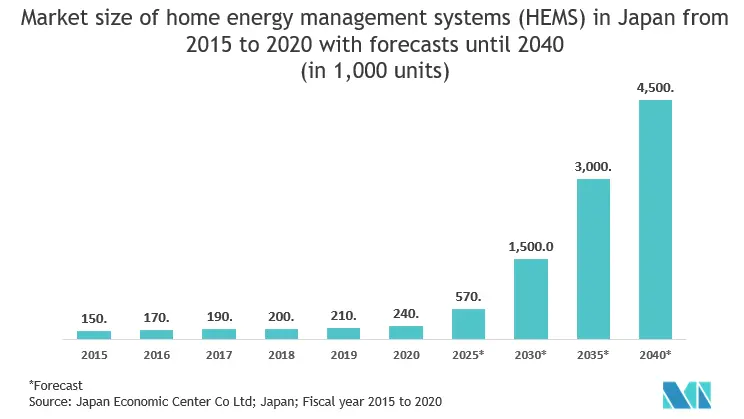Market Trends of APAC Energy Management Systems (EMS) Industry
This section covers the major market trends shaping the APAC Energy Management Systems Market according to our research experts:
HEMS (Home EMS) to Experience Significant Growth
- With the rapid improvements in technologies, like network communication, smart grid, bidirectional communication medium's, information infrastructures, energy conservation methodologies, and various techniques, home area networks (HANs) encountered a revolutionary change about multiple areas of power consumption domains, like energy conservation at consumption premises and electricity usage patterns.
- Due to the increasing concern about the efficient use of energy, there is an expanding focus on installing energy-saving devices in households. Energy management systems are cost-effective in all residential buildings, regardless of national energy prices, usage, and climatic factors. Thus they are increasingly being adopted in homes.
- Increasing investment in grid digitization by implementing advanced communications technologies will drive the growth of the residential energy management market. Over the next decade, China is investing USD 6 trillion in infrastructure as part of its urbanization development program. China and the economy, which have signed a cooperation agreement with China on the Belt and Road Initiative (BRI), are rising as a share of the world economy.
- In recent times, there has been a significant surge in the development of connected, intelligent devices, such as smart meters, smart sensors, and smart thermostats that are equipped in smart homes. These devices are experiencing advancements in power monitoring and display technologies.
- For instance, the Government of India planned to create 500 smart cities in a phased manner, with smart homes being the most critical entity of smart cities.

China is Expected to Hold Significant Share
- Over the years, Beijing has pursued an energy intensity target relative to GDP, allowing China to grow at a tremendous pace. However, just like the European Union, China has also put a cap on energy use by 2020. The Government in these regions is proactive in planning for smart meter installation.
- According to the World Green Building Council, China is the largest building construction market globally, with up to 2 billion square meters constructed annually, accounting for nearly half of new construction globally in the coming decade. It is also the world’s largest emitter of greenhouse gas emissions, which allows the country to invest in green buildings using energy management systems.
- Local vendors, especially in China, have AI in their core strategy, and few of them have been successfully raising funds. For instance, R&B Technology Holding, which specializes in creating energy management software for commercial and industrial (C&I) building sectors, led BP Ventures in its latest series of investments, raising USD 3.6 million. R&B’s energy management systems are specifically designed to predict, control, and improve building energy use. This solution supports BP Alternative Energy’s focus on low-carbon power, storage, digital energy value chain, and more comprehensive Energy as a Service (EaaS) offers.


